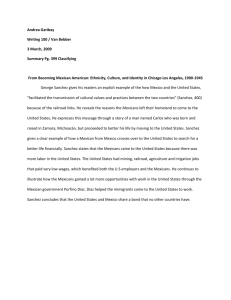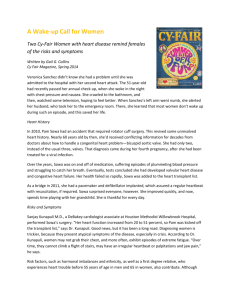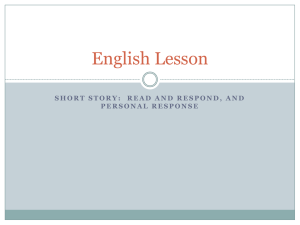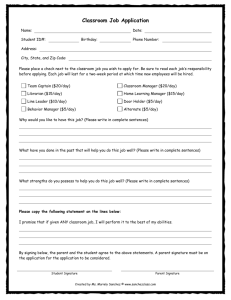EA Lesson Plan Outline
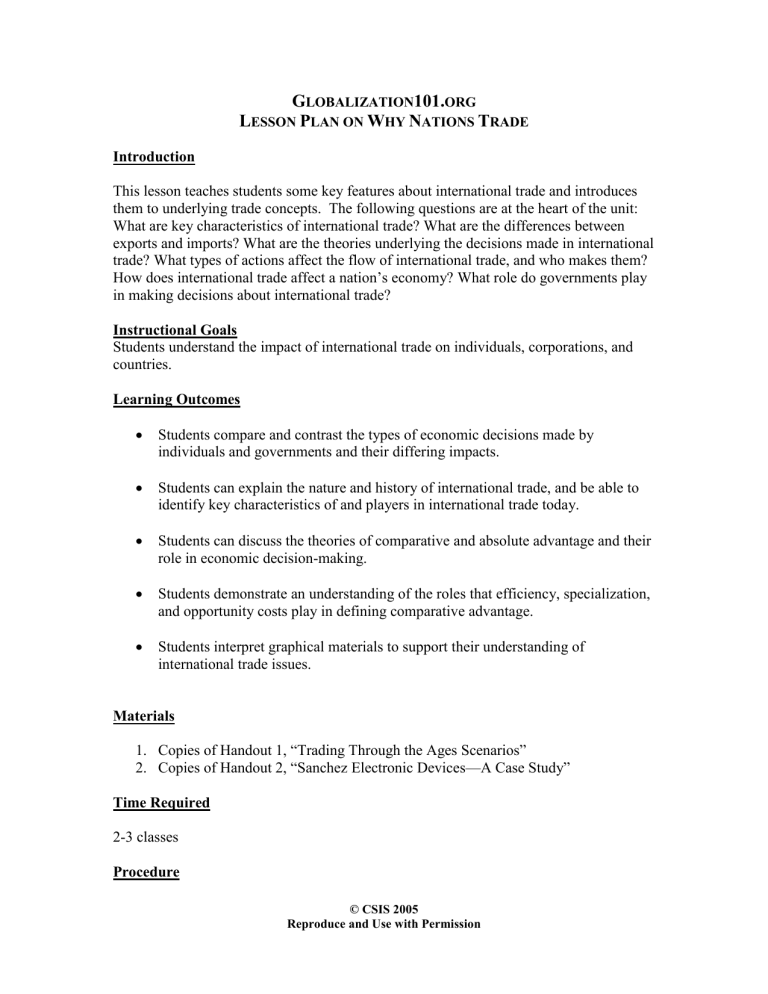
G LOBALIZATION 101.
ORG
L ESSON P LAN ON W HY N ATIONS T RADE
Introduction
This lesson teaches students some key features about international trade and introduces them to underlying trade concepts. The following questions are at the heart of the unit:
What are key characteristics of international trade? What are the differences between exports and imports? What are the theories underlying the decisions made in international trade? What types of actions affect the flow of international trade, and who makes them?
How does international trade affect a nation’s economy? What role do governments play in making decisions about international trade?
Instructional Goals
Students understand the impact of international trade on individuals, corporations, and countries.
Learning Outcomes
Students compare and contrast the types of economic decisions made by individuals and governments and their differing impacts.
Students can explain the nature and history of international trade, and be able to identify key characteristics of and players in international trade today.
Students can discuss the theories of comparative and absolute advantage and their role in economic decision-making.
Students demonstrate an understanding of the roles that efficiency, specialization, and opportunity costs play in defining comparative advantage.
Students interpret graphical materials to support their understanding of international trade issues.
Materials
1.
Copies of Handout 1, “Trading Through the Ages Scenarios”
2.
Copies of Handout 2, “Sanchez Electronic Devices—A Case Study”
Time Required
2-3 classes
Procedure
© CSIS 2005
Reproduce and Use with Permission
Introductory Discussion and Activity 1—Trading Through the Ages
1.
The introductory activity will expose students to basic characteristics of international trade—that communities will trade for what they need or want, that this trade has continued throughout recorded time, and that it has almost always involved some international components (increasing over time).
2.
Have students read the sections entitled, “
Why Do Nations Export
” and “
Why Do
Nations Import
” in the Trade Issue in Depth, either in printed format or on-line.
They may do so either in class or at home, depending on your preference and student access to computers. Alternatively, you may assign the reading as a follow-up to the activity.
3.
Distribute Handout 1. Divide the students into six groups and then assign each to one of the scenarios in the handout.
4.
Tell the students to focus on the following questions, as written in the Handout, which can also be written on the classroom chalkboard:
What types of goods and services are mentioned in the scenario? Which would be considered necessities by the members of the community, and why?
Where does the community get these goods and services?
How much of the community’s needs is met by getting goods and services from other communities? By their own community?
5.
Have the students read and answer the questions in their groups. Then, ask each group to select a spokesperson and have that person come to the front of the class.
Each spokesperson should read the scenario and answer the questions above.
6.
Have the entire class try to determine the historical chronological order in which the scenarios make the most sense using only the information in the scenarios and the answers to the questions. The answers are as follows:
Scenario 1:
Scenario 2:
Scenario 3:
Scenario 4:
Scenario 5:
Scenario 6:
Williamsburg, Virginia (17 th
Century)
Diné (Navajo) Village (15 th Century)
New York City (19 th
Century)
Samarkand, Uzbekistan (10 th
Century)
Home Town (21 st Century)
Ancient Village (5,000 years ago)
7.
When the scenarios are in the correct order, conclude the activity by asking the students broader questions raised by the exercise, as follows:
How has the definition of necessity and luxury changed over time as demonstrated by this chronology? Possible answers: we have new
© CSIS 2005
Reproduce and Use with Permission
necessities, old luxuries are now necessities, and people didn’t have a lot back then.
How has the nature of trade changed over time? Possible answers: the amount of trade has increased, the types of products traded have increased, and trade now goes on with groups from all over the world.
How has the nature of trade stayed the same? Possible answers: trade still involves some selling over great distances, people still exchange things they have for what they want or need.
What are some things that remain consistent regardless of the situation?
Possible answers: everybody tries to get their needs met, not everything comes from the same community; people trade with others, either in the community or out.
8.
You may expand on the discussion of the trade route known as the Silk Road in
Time Period 4, which discusses the city of Samarkand, an important connector along that route. Have students use links in the Globalization101.org Trade Issue
Brief and in the Links section of the site to research the Silk Road and report either orally in class or as a written assignment on one or more of the following issues:
Trade and technology – The role that differences in technology played in the development of the Silk Road.
Changing trade patterns throughout the history of the Silk Road.
Geopolitics and Trade – How did the politics and economy of the times lead to the development of the Silk Road, and how did they lead to its demise?
What environmental features affected the route of the Silk Road, and how did merchants address these?
What barriers restricted trade along the Silk Road, and how do these compare with current barriers to international trade?
The Silk Road as an early form of globalization.
Compare and contrast with today’s Silk Road (News Analysis, Silk Road
Revisited: http://www.globalization101.org/the-silk-road-revisited/ ).
Activity 2
1.
Introduce students to this topic by determining their familiarity with the idea of a case study. Case studies are useful because they examine a particular event, individual, or activity that illustrates some feature of a subject. This case study is intended to support student inductive reasoning, in particular, how to examine information and how to develop conclusions on more generalized themes. Note:
This is a hypothetical case study, and does not represent an actual individual, product, or series of events. It is for illustrative purposes only.
2.
Two types of questions are included: an initial set that focuses more on comprehension, and a second, supplementary set pose more analytical and
© CSIS 2005
Reproduce and Use with Permission
challenging questions. You may decide whether the students should use the first set, both sets, and selections from both sets.
3.
Distribute copies of Handout 2 to each student. Have them read the case study once, then read the questions, then go back and read the case study a second time more closely with the questions in mind. They should be encouraged to mark critical passages, key words, or ideas that support the questions.
4.
Students should then answer the questions using the reading and information in the Trade Issue Brief. The format for answers can vary according to your preference. Students may answer in written work either in-class or as homework or in class discussion. You may modify the assignment by having students answer only one or a few questions depending on the level of the class.
Conclusion
A number of follow-on activities can be used to extend the learning from this lesson using the Globalization101.org website. For example, you may encourage students to explore the links to the U.S. government and foreign government websites and to international organizations and advocacy within the Trade Issue in Depth. Students may use these links to research U.S. or other countries’ trade policies or learn about different perspectives on international trade. You may also assign students to read one News
Analyses on trade issues and have them apply their knowledge from this lesson plan to understanding the issues in the News Analyses.
© CSIS 2005
Reproduce and Use with Permission
Globalization101.org
Lesson Plan on Why Nations Trade
Handout 1
Trading Through the Ages Scenarios
Time Period 1—This community was the capital of a colonial settlement. Its residents consumed food they grew nearby and used locally cut wood for fuel. Most of the tools, clothing, and other necessities were provided by community craftsmen. More expensive products and luxury items were procured from the home country over the ocean, as the transportation and banking systems favored close trade relations with the colonists’ original land. The community participated in a plantation economy, purchasing slaves from overseas and providing tobacco and processed rum in exchange.
Time Period 2—The members of this community practiced agriculture in the deserts and river valleys of their homeland. They grew corn and beans to support their small communities. An extensive network of villages and roads in a peaceful environment increased trade opportunities. They used quetzal feathers from lands over 1,500 miles to the south in their religious ceremonies, and traded for minerals and other items from across the continental landscape.
Time Period 3—The growth over the last century opened up new opportunities for trade, by creating new markets for new materials from new sources. This city was at the center of this growth. The need for coal and iron to build trains, rails, and ships attracted investment from this city’s banking industry. Cattle and corn from the center of the continent passed through great port cities to feed the city and its neighbors. The city used phosphate mined on distant island countries to support its weapons factories. Tea and coffee were popular beverages, although grown in the far reaches of the globe. Cotton from hundreds of miles away made residents more comfortable, just as furs from the north made them more stylish. Advances in communication, such as the telegraph, made it easier to meet schedules and make deals from across the country and across the ocean.
Time Period 4—This was the leading city in a desert land, and was arguably one of the most important cities along a trade route which stretched from one continent to another.
This powerful merchant community participated in a complex trading network, as merchants from East and West would meet in its markets and trade for items unavailable in their own countries. Silk and paper, the secret of whose production was kept for centuries by Eastern traders, was traded for exquisite rugs and carpets produced near the market city. In turn, these products were traded for gold (and other precious metals), raw materials, and fine items made or mined in the West. Although this city was supplied with its basic necessities from nearby river valleys, it rose to become one of the greatest commercial centers the world has seen.
Time Period 5—The explosive expansion of the world economy over the preceding three centuries dramatically affected this community. Most of this community’s residents were only slightly aware of the level of internationalism of the trade that brought them so
© CSIS 2005
Reproduce and Use with Permission
much. The plastic materials in computers, cars, clothing and entertainment devices were formulated from petroleum purchased from dozens of sources. The community consumes coffee, soda, fruit, meat, and vegetables as likely to come from the other side of the world as from their own country, but least likely to come from their own neighborhood. The strong flow of raw materials from resource-rich countries to their community was matched by the flow outwards of new products, intangibles like information and communication and services, that comprised an ever-increasing portion of the world economy. The necessities and luxuries that made up the daily life of the residents were rarely made in the community, and items made or services provided by the community were just as likely to be in demand in other countries.
Time Period 6—In this small, isolated village a community maintained a stable yet precarious existence, with little change in population over the centuries. Food was provided through agriculture and supplemented by hunting and gathering. Almost all clothing and tools were made by community members from natural sources near the village. Every year members of the village met with members of nearby villages and trade for a few precious products, such as religious items or perhaps new and unique weapons or tools. In return, they provided raw minerals or salt from sources near their community.
© CSIS 2005
Reproduce and Use with Permission
Globalization101.org
Lesson Plan on Why Nations Trade
Handout 2
Sanchez Electronic Devices—A Case Study
Roberto Sanchez worked for 20 years as an engineer and manager in a factory in
Dearborn, Michigan. After he left the company, he had a number of decisions to make such as: What would he make? Where would he locate his factory? Where would he sell his product?
After extensive research, Mr. Sanchez determined that he would build a small factory making a new product: a small tool useful for making personalized computer identification tags. Mr. Sanchez had experience in this sort of product, and had many friends in the United States and overseas who might be interested in the device. He built his factory in the middle of Cleveland, Ohio, where he knew he could get raw materials cheaply, the workers he would hire would be well-educated and hard-working, and transportation and communication networks would help him sell his device wherever it was wanted.
Mr. Sanchez prospered for many years. Although he sold most of his devices in the first few years to local computer dealers, over time he found the greatest interest in Japan and
India for his product. Eventually, most of Mr. Sanchez’ devices were exported to these countries. His factory expanded its production, and he and his employees were amply rewarded.
Although competitors in these countries tried to make similar devices and sell them, no one could match Mr. Sanchez’ quality nor the service he provided. In addition, because the United States was in a recession at the time, the U.S. dollar was not worth as much overseas (compared to other currencies). A weak dollar meant that foreign purchasers would get more for their money, and they were therefore eager to do business with
American exporters. American business people, on the other hand, could not import as much as they would have liked because their money was not worth as much in these countries.
A dilemma faced Mr. Sanchez, however, over the next few years. The continued success of his device encouraged others to make similar devices, and though not of the same quality, they forced him to lower prices in order to compete more effectively. Many of the workers had been with Mr. Sanchez since the beginning and their pay had been raised to the point where he had a hard time making much profit. Finally, as the U.S. economy prospered, the dollar began to increase in value, and importers in other countries found they could not make as much money reselling the items in their stores. In response to these challenges, Mr. Sanchez tried to find a way to lower his costs. Otherwise, he would have lost money and been forced to close down his business.
© CSIS 2005
Reproduce and Use with Permission
Throughout the development of his business, Mr. Sanchez had kept a close eye on government trade policies. Early on, the government encouraged Mr. Sanchez by helping him make business connections in Japan and India. The government forced importers with devices similar to Mr. Sanchez’ to pay a small tax on each item brought into the
United States. This tariff increased the cost of the foreign goods, and helped Mr. Sanchez in the early days of his business.
Over time, however, U.S. importers began to complain about these tariffs. These importers claimed that the tariffs not only raised the cost of the devices made overseas, but since Mr. Sanchez could not make enough of the products in the United States,
Americans were not able to get as many of the devices as they needed. The U.S. government eventually decided that, although Mr. Sanchez deserved to make a profit based on his hard work, American buyers should not have to suffer with the high import tariff. The government, therefore, eliminated the tariff.
Mr. Sanchez faced a real crisis. His sales to other countries were dropping rapidly because his device was no longer that inexpensive and Indian and Japanese business people had started to match his quality. Furthermore, his sales in the United States were no longer assured because now the Indian and Japanese devices were being sold in the
United States for less than he could afford to make them.
Although Mr. Sanchez could not change the government’s decision to reduce the tariff, he could make some decisions to help his company. After looking at the facts, Mr.
Sanchez regretfully closed his factory in Cleveland and opened a new one in Ciudad
Juarez, Mexico, just over the border from El Paso, Texas. He found that he could pay skilled workers half of what he had to pay in Cleveland. He also decided to reduce the quality of his product by buying less expensive parts and using a faster assembly process.
With these substantial changes, Mr. Sanchez was able to reduce his costs, make a small profit, and stay in the business he loved.
© CSIS 2005
Reproduce and Use with Permission
Case Study Questions
1.
Specialization means to produce those goods and services which you can make most efficiently and with the greatest cost advantage. What good did Mr.
Sanchez specialize in? What were his reasons?
What are some examples of specialization in the global context? Are there particular regions or countries that have historically specialized in a product or group of products? What are the reasons for that historic specialization? Are there regions or countries that have only recently begun to specialize in a product or group of products? What changes in technology, trade, or other areas do you think lead to this specialization?
2.
What types of decisions did Mr. Sanchez make? What types of actions did the government take? How did those decisions or actions affect the success or failure of the business?
What factors might have led Mr. Sanchez to make a decision other than the one he chose? How would access to information affect the decisions made by Mr.
Sanchez?
3.
To export means to sell goods or services to foreign markets. To what countries did Mr. Sanchez export his devices?
In some countries, export-oriented industries are the primary source of employment. What are the advantages and disadvantages of relying heavily on exports? How might a strong export-oriented economy affect employment? Can you think of an example in which a country relies almost completely on export of one good? How has this affected the country?
4.
To import means to sell goods or services made in other countries in your home market. What products discussed in the case study were imported into the United
States? How did this affect Mr. Sanchez?
What imported products are available in your community? Is there any additional value associated with the importation of any of these products (i.e., French wine,
Italian shoes, Japanese electronics)? What affect on a country’s culture might result from widespread availability of imported goods and services?
© CSIS 2005
Reproduce and Use with Permission
5.
The exchange rate is the comparative value of two currencies, i.e., how much one currency is worth in the other currency. What role did the exchange rate play in
Mr. Sanchez’ ability to sell his products when he started? How did the change in the exchange rate over time affect Mr. Sanchez’ ability to sell his devices?
How might the adoption of the US dollar as the currency in some Latin American nations affect trade between those nations and the US? In 2002, much of Europe adopted a single currency, the Euro. What might be the affect of this change, particularly on a country with a very weak currency (such as Greece) or a very strong currency (such as Germany)? How might a rapid devaluation of a currency, such as in Germany in the 1920s and Argentina in 2002 affect the country’s economy?
6.
A trade barrier is a governmental policy that affects the flow of trade. What trade barrier, put in place by the government, initially helped Mr. Sanchez? What happened when that barrier was removed?
What are some products that have barriers or tariffs restricting their trade
(imposed either by the US or its trading partners)? How might a barrier based on communication, trust, and reluctance to import US products (such as in Japan) differ from a formal trade barrier? With this example, why might a removal of a formal trade barrier have little or no effect? What are the dangers of removing a trade barrier?
7.
What were the goals of Mr. Sanchez in opening his factory?
8.
What were the goals of U.S. government policy when Mr. Sanchez opened his factory? How did these goals change over time? Why do you think they changed?
In what way have recent Presidential administrations supported the removal of trade barriers? Why did most public opposition to the North American Free Trade
Act (NAFTA) center on the issues of the environment and employment? How did
NAFTA address these issues? How are the issues that surround the World Trade
Organization (WTO) different from those of NAFTA, and how are they similar?
© CSIS 2005
Reproduce and Use with Permission

